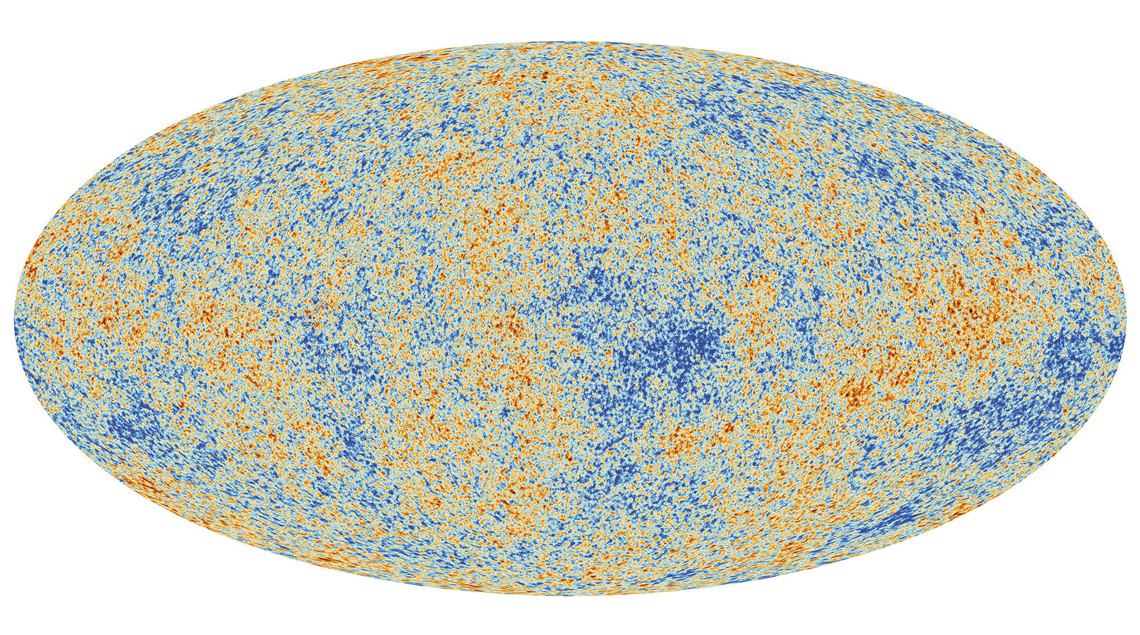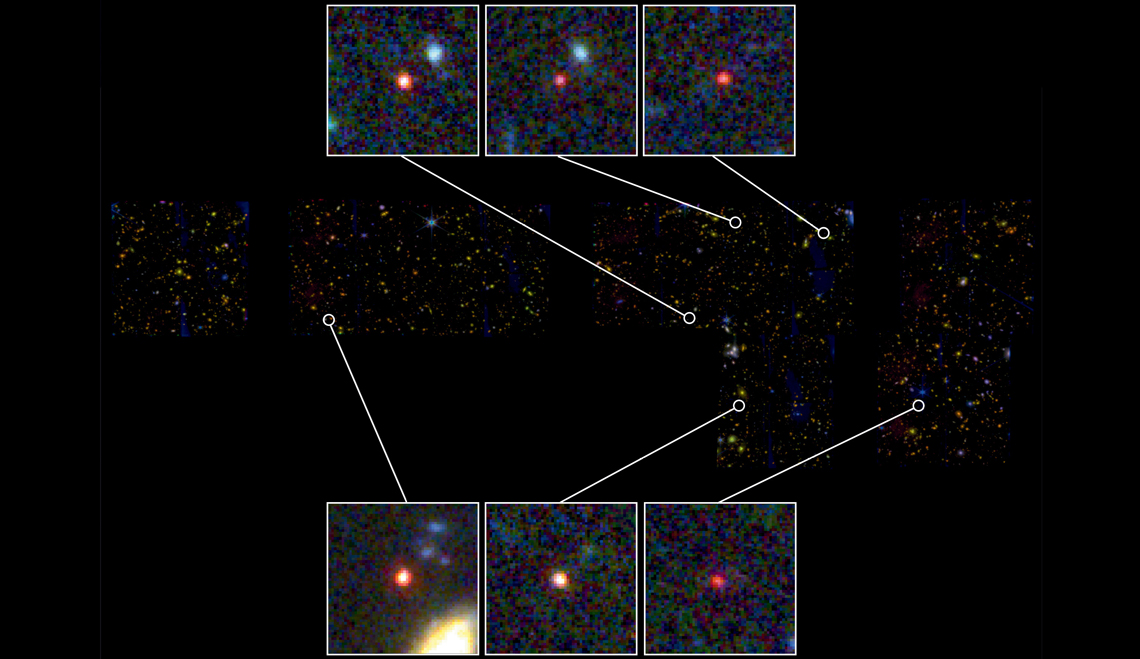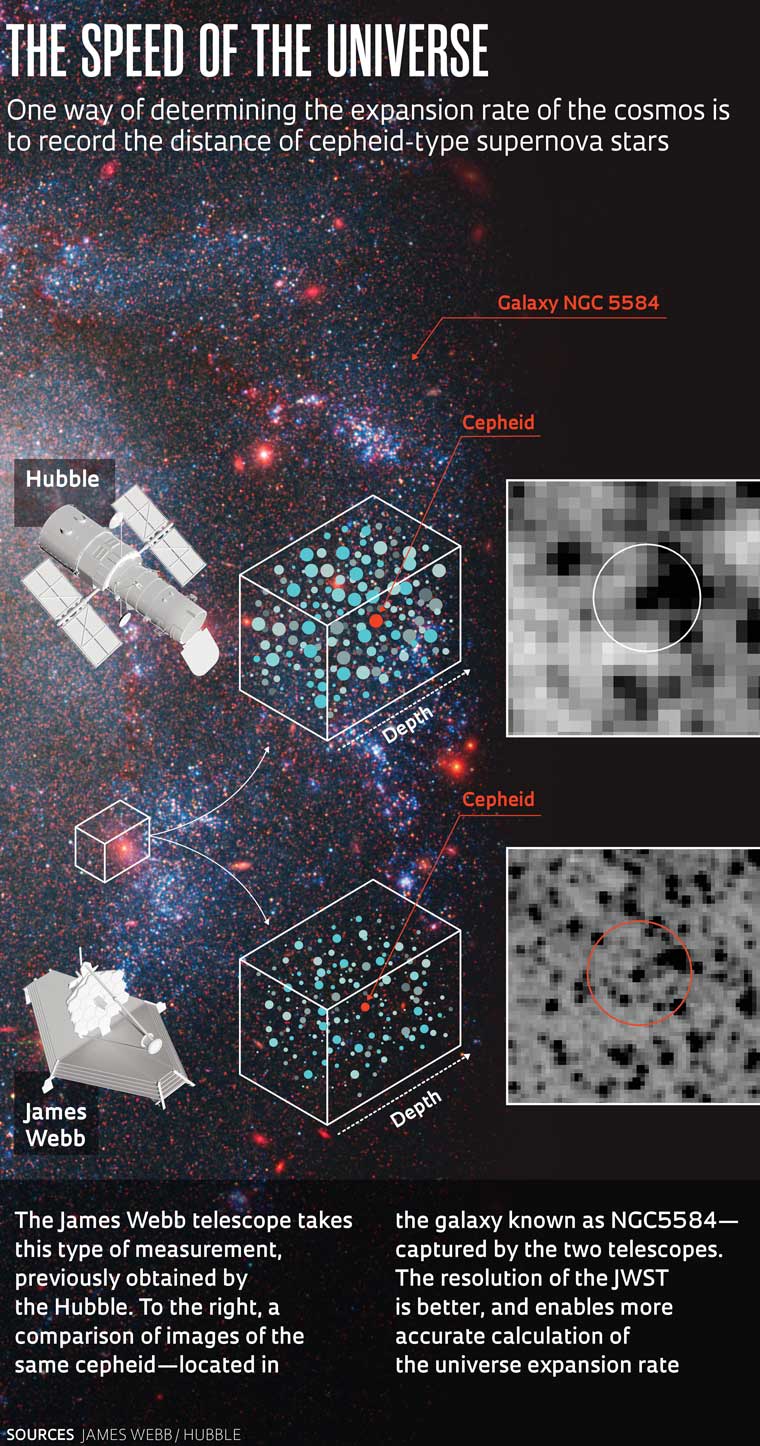Technical advances in the capacity to observe nature normally provide initial clues on theretofore unsuspected settings and generate more precise data on known phenomena. Two recent studies drawing on information and images produced by the James Webb Space Telescope (JWST), the most costly and powerful apparatus ever launched into space to study the universe, reveal findings that support this and deviate somewhat from the prevailing theory on the formation and evolution of the cosmos.
One pertains to the unexpected discovery in the emerging, remote universe of mature galaxies, structures which, in principle, should only appear later. The other substantiates a decades-long discrepancy over the rate of the universe’s expansion, a key parameter for understanding the celestial dynamics of stars, galaxies, black holes, planetary systems, and everything else in space. Alongside the discovery of ancient stars, this growth rate is an important factor in deducing the actual age of the cosmos, currently estimated at 13.8 billion years.
These data, which have stirred up a certain level of unease and excitement, began to emerge at the beginning of this year. A February article published in the scientific journal Nature reported the probable discovery of six galaxies being fully formed when the universe was still in its infancy, and only 5% into its current lifespan. Between 500 and 700 million years after the Big Bang, the primordial explosion believed to have engendered the cosmos, these galaxies were already almost the size of the Milky Way.
“These objects are significantly more massive than anyone expected,” said astrophysicist Joel Leja, of Pennsylvania State University, and lead author of the study, in a press release. “We were only expecting to find newborn, small, and young galaxies in this period, but we discovered galaxies as mature as ours at the time of what was previously understood to be the dawn of the universe.”
Unlike the stunning images of other celestial bodies captured by the JWST, with their impressive wealth of aesthetic detail, the portrayals of these primitive galaxies are nothing more than blurred dots, colored in red to highlight them. They may be disappointing on the eyes, but are certainly not so for the researchers; never had such advanced galaxies, which appear to lie outside their habitual time and space, been observed in the early stages of the universe.
“The discrepancy was not small. The discovery is like finding parents and their children at the same moment on a timeline in which the grandparents are still children,” wrote Brazilian theoretical physicist Marcelo Gleiser, of Dartmouth College, and astrophysicist Adam Frank, of the University of Rochester, in a September opinion article in The New York Times. In the commentary both scientists, who did not participate in the initial studies of the James Webb data, said that the new information provided by the supertelescope, along with other unresolved questions, may lead to a review of cosmology.
“The JWST is just beginning its observational lifespan, and is still being calibrated. We need to wait a few more months for more consolidated data,” says astrophysicist Thiago Signorini Gonçalves, of the Federal University of Rio de Janeiro’s Valongo Observatory (OV-UFRJ), who studies the formation and evolution of galaxies. “But the revelation of these galaxies, formed just before the Big Bang, was a surprise.”
The new telescope was launched in December 2021, with its first images received in July last year (see Pesquisa FAPESP issue nº 318). It is considered a type of successor to the Hubble telescope, still operational. Its primary mirror has a diameter of 6.5 meters and an aperture six times bigger than that of the Hubble.
It was chiefly designed to observe the so-called dark ages of the universe, from 300 million years after the Big Bang, a period in which the cosmos was little more than a thick cloud of hydrogen gas. Little by little the matter started to concentrate, and the first stars and galaxies emerged. This phase of the universe can be observed in detail using infrared technology. As the cosmos is expanding, the faster a galaxy develops, the farther it will be from Earth, under which conditions the Doppler effect reduces the frequency of emitted light from visible to infrared, and for this reason the James Webb telescope essentially operates using the latter.
If it is not easy to explain the existence of this sextet of precociously developing galaxies in the earliest beginnings of the universe, it is yet more difficult to reconcile a discrepancy of almost 9% between the current values, obtained through two different methods, of the universe’s expansion rate. This parameter is commonly known as the Hubble in a reference to its creator Edwin Powell Hubble (1889–1953), for whom the famous telescope was named.
The expectation is that the James Webb telescope, with its vast observational capacity, will put an end to this discrepancy, nicknamed the Hubble Tension. This is yet to happen. “It’s a really important question,” remarks theoretical physicist Gustavo Burdman, of the University of São Paulo’s Institute of Physics (IFUSP). “If it’s not resolved, physics may need to be reexamined, and the cosmological model altered.”
One way of calculating the universe’s rate of expansion is by using analysis of cosmic microwave background radiation. This parameter is a remnant of electromagnetic waves issuing from the first stars formed some 380,000 years after the Big Bang, when the cosmos began to cool. On measuring the properties of this radiation—a type of fossil of the nascent universe—it is possible to calculate the Hubble Constant.

ESA / PLANCK
Map of fluctuations in the temperature of background cosmic radiation emitted 380,000 years after the Big Bang
ESA / PLANCK The Planck satellite of the European Space Agency (ESA) very accurately measured background cosmic radiation in 2013, producing a Hubble-Constant value of 67/68 kilometers per second for each million parsecs (km/s/megaparsec). One parsec corresponds to 3.26 light years.
The other method used to calculate this expansion rate is based on recording the variation in the distances of stars over time. This is generally done by observing stars known as cepheids, a type of giant supernova whose brightness varies with a certain frequency, making them useful for determining distances, and by this technique the current expansion rate of the universe was calculated at 73/74 km/s/megaparsec. Data from the Hubble telescope were instrumental in obtaining this number.
In October this year, a group led by astrophysicist Adam Riess of Johns Hopkins University published an article in Astrophysical Journal Letters with a new calculation of the Hubble Constant, this time using 320 cepheids from two galaxies: NGC4258 and NGC5584, observed by the JWST. With an even greater level of accuracy, the result ratified that when calculated using this approach, the Hubble Constant is 73/74 km/s/megaparsec.
According to Riess, previous Hubble telescope measurements were correct, although there was more dirt in the data. The researcher was one of the physics Nobel laureates of 2011 for his studies with cepheids, which provided evidence that the cosmos is expanding at a rapid rate. “What these data do not yet explain is why the universe is expanding so quickly,” he noted in publicity content on the study.
Moreover, they do not mean that the expansion rate of the universe calculated by the method using background cosmic radiation is wrong. “Measurement of the Hubble Constant attained a high level of precision, with a margin of error around 1%. However, the two independent ways of calculating it diverged significantly—some 5 standard deviations,” explains Rogério Rosenfeld of the Institute for Theoretical Physics at São Paulo State University (IFT-UNESP). “This could indicate the need for a shift in the standard cosmological model.” The model currently suggests that the cosmos is made up of 5% normal (visible) matter, 26% dark matter, and 69% dark energy. The nature of these two latter components is unknown.
It is possible that continuation of the Hubble Tension will provide an indicator that there is an essential ingredient missing in the composition of the universe. In an article published in October this year in the scientific journal Physical Review D, Rosenfeld and a collaborator explore the idea of introducing a new kind of component into the standard cosmology model—incipient dark energy, thought only to be present in the nascent universe.
Its inclusion may give rise to a correction of the universe’s expansion rate calculated using background cosmic radiation to a number compatible with that obtained through analyzing the movement of cepheids, a real possibility. Others may arise as the James Webb and other modern observation instruments provide increasingly more accurate data on different objects, epochs, and phenomena of the cosmos.
Republish



